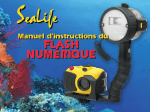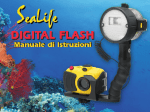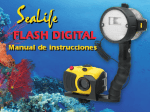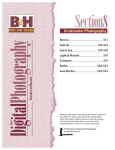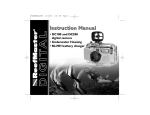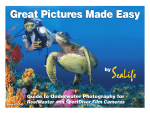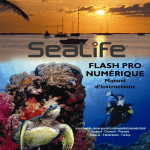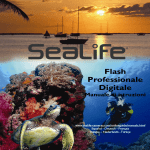Download Sealife DC310 Instruction manual
Transcript
DIGITAL FLASH Instruction Manual with Tips from the Pros Contents: I. SeaLife Digital Flash Features and Benefits .......PAGE 2 III. Picture samples .....................................................PAGE 5 IV. Preparing your Digital camera and Flash............PAGE 7 V. How to use Digital Flash underwater ..................PAGE 25 VI. Tips from the Pros .................................................PAGE 31 VII. Care and maintenance ..........................................PAGE 42 VIII. Glossary ..................................................................PAGE 44 IX. Troubleshooting Guide ..........................................PAGE 46 X. Accessories, and Related Products.....................PAGE 51 XI. Warranty Statement and service..........INSIDE BACK COVER www.sealife-cameras.com/onlineguide/manuals.html Español - Deutsch - Français - Italiano 1 I. SeaLife Digital Flash Features and Benefits Universal Underwater Flash for all film and digital cameras* • Deeper, richer colors and reduces backscatter • 5 pre-flash cancellation settings • Variable power adjustment for correct image exposure. • Flash Link optical cable connection included • Includes universal mount to adapt all SeaLife cameras and other underwater camera housings with tripod mount. • Flexible, rubberized arm for easy aiming and sure grip. • Effective underwater distance range up to 8 feet (2.5m) • Two Digital Flashes can be mounted to the camera. • Depth rated to 200 feet (60m) • Approximately 100 flashes with 4 AA batteries (not included) • Deluxe carry case included. *Works with digital cameras that have up to 4 pre-flashes 2 Without Digital Flash With Digital Flash Novice and experienced dives alike know that the deeper you dive the less light penetrates the water column. While this descending drama adds to your excitement as a diver, you will find that it also will challenge you as an Underwater Digital Photographer. Having an external Digital Flash allows you to carry your own supplemental light with you. 3 The SeaLife Digital Flash is fully adjustable allowing you to control the brightness of your “sun” as you need. The variable power adjustment lets you accent colors and bring out the brightness of a reef scene or the brilliant blue and yellows of an Angelfish gliding by you. Plus, the SeaLife Digital Flash allows you also to choose a preflash setting that will synchronize your cameras’ flash system with that of the SeaLife Digital Flash making your underwater images sharper than ever. By reading and following the simple instructions in this manual you will be able make your images come to life with colors and details more brilliant than ever. 4 III. Picture samples – you can do this! 5 Photos by John Chandler with SeaLife DC310 digital camera, Wide-Angle Lens and Digital Flash 6 IV. Preparing your camera and SeaLife Digital Flash Prepare your camera for use underwater. Here is a simple checklist that is useful for most popular digital cameras and their housings. • Insert blank memory card. It’s good practice to regularly format the memory card. Make sure card is blank before formatting. • Insert freshly charged batteries. High mAh batteries are suggested. Such as the SeaLife NiMH AA rechargeable batteries. • Turn camera power on • Set SeaLife digital cameras to External Flash exposure mode (see camera instruction manual for details) For non-SeaLife camera’s: • Set ISO (start with 200 ISO) • Set White Balance to AUTO • Set camera’s Flash to ON (Turn off pre-flash, if possible) 7 • Important: Turn off camera’s red-eye reduction. • Select your desired image resolution. • Use camera’s manual exposure mode to control aperture and shutter speed, if possible. • Read your digital camera instruction manual for how to adjust the above mentioned cameras settings. • Inspect and clean camera housing and main O-ring (Make sure O-ring is not damaged and perfectly clean). • Insert camera into housing and seal. • Test fire the camera to make sure camera’s flash fires. 8 Prepare your Digital Flash Open latch as shown below to access battery compartment and preflash cancellation setting. Important: Make sure the Flash (and you) are perfectly dry before opening compartment 9 Caution: Discharge flash. Before opening flash housing door, make sure to discharge the flash by moving the power switch to the “TEST” position, and then to the “OFF” position. Magnetic switch. The switch has small magnet inside to turn flash power ON/OFF and TEST. Keep away from compasses and electronics to avoid magnetic interference. Do not force switch beyond its stop point to avoid damaging the switch. Sealing Latch. Grab the sides of the latch in order to open the battery compartment. Make sure the latch is properly closed before each use. DO NOT apply external force to latch or hinge area to avoid damage. Check O-Ring to ensure it is clean and not damaged. 10 Insert new or freshly charged AA batteries. Use SeaLife NiMH rechargeable batteries for best results. To replace batteries, gently press down on the top front of the battery magazine and slide the magazine cover down. Replace all 4 batteries with Alkaline or NiMH type batteries ensuring the polarity is properly observed. NiMH recycle time and life depends on mAh rating of the battery. A 2300 mAh NiMH battery will last longer and recycle faster than a regular alkaline battery. There is also newer high energy Alkaline batteries available that will have longer battery life than regular alkalines. Note: You can remove the entire battery compartment for easy access to batteries, or for replacement purposes. Push down release tab next to battery compartment and slide the entire compartment towards the release tab. 11 Setting the preflash cancellation switch. For all SeaLife digital and film camera’s, set switch to “0” position. For all non-SeaLife digital cameras, set switch to the # 4 position to start. • Turn Digital Flash power ON. Wait for the “ready light” to illuminate. • Turn on your digital camera and take a test picture of the Digital Flash. Aim camera at the Digital Flash light sensor. • Review image on the camera and see if the Digital Flash firing is visible in the picture. If you see the Digital Flash firing in the picture, keep the switch set a #4 (this indicates that your camera uses 4 pre-flashes). 12 • If you do not see the Digital Flash firing in the picture, set the switch to the #3 position and repeat the above test. • Continue moving switch down one position until you see the Digital Flash firing in the picture – This will be your permanent pre-flash cancellation setting. Note: For the above test, keep the shooting distance between the camera and Digital Flash at about 5 feet (1.5 m). Do this test in low light conditions, away from bright or direct light. Make sure that one of the light sensors is exposed (not obstructed) for above test. Important: If you are using a digital camera other than SeaLife, disable the camera’s Red-Eye reduction. Set your camera flash to FLASH ON. Check the camera’s instruction manual for details. Tip: If you are using a digital camera other than SeaLife, disable the camera’s PRE-flash, if possible. Check the camera’s instruction manual for details. This will allow you to use the #0 pre-flash cancellation setting. 13 Pre-flash cancellation settings: The Pre-Flash cancellation switch setting matches the number of preflashes of your camera: Switch position 14 Description of setting 0 Instant synchronization mode. For cameras with No pre-flash. Use “0” setting for all SeaLife cameras an other brands that allow you to disable the camera’s pre-flash. 1 One pre-flash 2 Two pre-flashes 3 Three pre-flashes 4 Four pre-flashes Close and seal battery compartment as shown. Make sure O-ring is perfectly clean and undamaged. Note: Inspect O-ring for cuts, tears, dirt or other damage. Clean or replace as necessary. See page 43 for O-Ring care instructions. 15 Carefully inspect that the latch is closed and the O-ring is completely seated into the housing. 16 Attach camera (housing) to DIGITAL FLASH mounting base. Hand tighten screw – Do not over tighten! Caution: A) Only attach mounting screw to housings with standard 1/4 - 20 tripod mount adapter. B) The tripod mount adapter thread depth MUST be at least 0.250” (6.4mm). Never force or over tighten screw, or this may permanently damage the housing seal or threads. 17 Attach Flash Link optical cable to Digital Flash head and camera Refer to the Flash Link instruction manual for details. The Flash Link optical cable will transfer the flash from the inner camera to the light sensor of the Digital Flash. 18 Test Flash Turn ON/OFF switch on top of flash to “ON”. When green flash-ready light is on, turn switch to TEST. This will test fire the flash. New or freshly charged batteries will yield about 100 flashes. Important: Do not force switch beyond stop point 19 Test Pictures Turn on camera and Digital Flash and take some test pictures to make sure camera’s flash and Digital Flash fires together. Check that both the “ready lights” of the camera and Digital Flash are illuminated. Digital Flash-Ready Light: Light off – Indicates flash is charging or flash is turned off Light Steady on - Indicates flash is charged and ready Light fast blinking (4 seconds) - Indicates flash has just fired Light slow blinking - Indicates flash battery power is low Aim Digital Flash head towards the subject. If using the SeaLife macro lens, make sure to aim the flash downward and toward the subject. For 8X and 16X lenses, aim flash down and toward the end of the macro wand. For 3X Close Up lens, aim flash to a point about 3 ft in front of the camera. 20 The flexible arm consists of seven 1-inch (2.5cm) links covered by a foam rubber sleeve. You can bend the flexible arm in any direction. If you want to take the arm off or apart, you can bend it beyond the point of resistance, until the link separate. The links can easily be reconnected by pushing them together until they snap in. The maximum reach of your flash output is about 6 to 8 feet and depends on the reflection of the subject, angle to the subject, color of the subject and water visibility. The SeaLife Digital Flash is fully adjustable from a maximum output of 20 guide number (100%) down to a minimum output of 1.6 guide number (8%). Refer to Section V for more information on the adjustable features of your Digital Flash. 21 The built-in flash of the camera should be covered by a flash deflector to prevent unwanted backscatter of light caused by a reflection from particles floating in front of the camera lens. All SeaLife cameras come with custom made deflectors that attach to the bottom of the flash base and align over the camera’s flash. For non-SeaLife cameras, remove the deflector. Use the black sticker provided with the Flash Link to cover the camera’s flash and secure the optical cable. See Flash Link instructions for details. Tip: Use the SeaLife Flash Diffuser (SL968) to reduce flash output by about 60% and “soften” the light intensity. 22 Use of a second Digital Flash. In order to avoid shadows and to further intensify brightness and color, you may mount a second identical flash. Remove the attachment knobs from both flashes. Place a longer mounting screw through both base mounting brackets and into the camera housing. Rotate both flash heads to point in the direction of the subject and parallel to the lens of the camera. 23 A camera with two Digital Flashes This double flash system can also be used with the SeaLife Macro Lenses at a distance of 8” to 48” (20cm-120cm). A good way to avoid overexposing close range images will be to illuminate the background with one flash at full power setting while illuminating the foreground and subject with the other flash with a lesser power setting. A SeaLife diffuser may be used on both flashes to prevent overexposure of closeup subjects. Note: A longer mounting screw is required when mounting two Digital Flash flash units. Contact your local dealer to order. Item #SL96022—for two flashes Item #SL06026—for two Digital Flash units and macro wand 24 V. How to use the Digital Flash underwater Making camera adjustments for proper image exposure is easy with a little practice and knowledge. Just follow these few guidelines with your SeaLife camera or other digital cameras (in a suitable housing). Overexposed picture Properly exposure picture You can adjust your camera setting and/or Digital Flash settings to achieve the best image exposure 25 Adjusting camera settings For SeaLife digital cameras, set the camera to External Flash mode. For more details refer to your SeaLife camera instruction manual. For non-SeaLife cameras, set-up the digital exposure settings as recommended here. ISO Choose and set an ISO appropriate to the conditions you expect on your dive. The deeper you go means less light. You can adjust for this by adjusting the sensitivity of your camera’s sensor (ISO). 26 Depth Visibility Light ISO 15-30 feet (5-10m) 20+ ft. (6m +) bright, sunny 100 30-60 feet (10-20m) 10-20 ft. (3-6m) medium, cloudy 200 60-90 feet (20-30m) 0-10 ft. (0-3m) dark, night 200 or 400 You notice the deeper you go, the lower the visibility. The darker the light conditions are, the higher the ISO. This makes your camera more sensitive to light and will serve to compensate for the absorption of light at depth. Exposure Value (EV) also allows you to increase, or decrease, the camera’s light sensitivity. Increase EV to brighten images, and decrease EV to darken pictures. You may choose to increase the EV setting depending on depth, visibility or ambient light. Depth Visibility Light EV 15-30 feet (5-10m) 20+ ft. (6m +) bright, sunny -2 30-60 feet (10-20m) 10-20 ft. (3-6m) medium, cloudy -1 60-90 feet (20-30m) 0-10 ft. (0-3m) dark, night 0 NOTE: The color of your object will effect the brightness of your subject and the selection of your ISO or EV may be effected. Check you camera instructions for more information about ISO and EV 27 White Balance (WB). This setting will match the color temperature (not heat) of the light source to your camera’s sensor. Before using the SeaLife Digital Flash set your WB to AUTO. Set White Balance to FLASH, if available. Manual exposure controls Most digital cameras also offer a manual mode that allows you to adjust the aperture and shutter speed. This provides the best overall exposure control but requires some experimentation and a little knowledge of basic photography principles. Refer to your camera instruction manual for details. Once you have your camera exposure settings adjusted, take some test pictures to become comfortable with the use and handling of the Digital Flash. Remember that the flash reaches about 8X farther on land than underwater. Consider this fact when taking test pictures on land and make sure your subject is father away. The best practice is taking underwater pictures. TIP: Once you have settings that give acceptable results, note the settings. Experiment to see how changes affect image exposure. 28 Using the Digital Flash variable power adjustment: If the test image is over exposed (white or washed out colors), turn the power adjustment clockwise to the first “bar” and take another picture. Do this until the image exposure is satisfactory. If the test image is under exposed (dark), make sure the power adjustment is on full power (completely counter clock-wise). If the power adjustment is turned to full power, and the image is under exposed, it normally indicates the subject is too far away, beyond the reach of the Digital Flash or the flash did not fire. The maximum reach is 6 to 8ft (2.5m) depending on water visibility. Note: If the Digital Flash did not fire, refer to the trouble shooting guide in section IX. 29 Important: For SeaLife digital cameras, make sure camera is set to External Flash mode. See camera instructions for more details. Tip: For SeaLife DC300 and DC310 Digital cameras, press the LCD button once to set the camera to “FAR FLASH”. This will increase the sensitivity of the camera and brighten the image. This is helpful for longer shooting distances. Press the LCD button again to set the camera to “MACRO FLASH”. This will reduce the sensitivity of the camera and darken the image. This is helpful for proper image exposure for short distances (Macro shots) 30 VI. Tips from the Pro’s STEPHEN FRINK Stephen Frink is the world’s most widely published underwater photographer. With a career spanning over two decades, his photos have appeared in a wide variety of dive journals and magazines world-wide, and he has provided stunning imagery for hundreds of promotional campaigns. For more information about Stephen Frink Photography, please visit www.stephenfrink.com. Digital Photography underwater is a very powerful medium. With obvious advantages like greater capacity per dive and immediate review of photos taken, the learning curve is tremendously accelerated for most shooters. Add powerful accessories like the SeaLife Digital Flash and accessories such as the wide angle lens and macro accessories and digital rules the underwater imaging scene. 31 Still, there are a few principles that can make even digital photography better: STEPHEN’S TIP 1: MINIMIZE BACKSCATTER Backscatter is the most important variable in point-and-shoot photography because the strobe is near the lens with most systems. Particles in the water are front-lit by the flash and appear as specks of “backscatter.” These are some of the best ways to eliminate backscatter: • Work in the clearest possible water. • If the water is dirty, find a busy, visually confusing background that may hide particles. • Avoid shooting into the open water column, which will accentuate particles. • Don’t make backscatter worse with poor buoyancy skills. Avoid stirring the sand on the bottom or dislodging the silt on a sponge. 32 • One important advantage with the SeaLife Digital Flash, is that when particles are illuminated, it is with rim-light rather than front-light, and the backscatter effect is minimized. • Position your strobe high and to the side, pointing down to the subject. STEPHEN’S TIP 2: SHRINK THE WATER COLUMN Water — 800 times denser than air — quickly absorbs light and is a massive cyan (blue-green) filter. So, to achieve rich, vibrant colors in underwater photography, you must: • Use artificial light (a strobe). • Work close. Choose a point-and-shoot that focuses to at least two feet with a primary lens, or has an easy system of adding supplemental lenses to get close. 33 STEPHEN’S TIP 3: CHOOSE THE RIGHT SUBJECT Because the best results will be obtained when working close, there is a limited universe of subjects possible with these cameras. With the normal lens on a SeaLife digital camera a full-figure shot of divers must be taken from eight to 10 feet away, making the shot inevitably monochromatic blue. Applying the “get close” axiom, a head-and-shoulders shot taken from three feet away will be better. Or, add the Wide Angle lens to photograph large subjects from a near distance. The normal lens is usually good for fish portraits, whereas the wide angle lens helps for large marine life such as dolphins, reef scenes, and photographs of your dive buddy. 34 STEPHEN’S POINT-AND-SHOOT WORKSHOP This series of four photos taken with the SeaLife flash shows the tremendous effect water has on color saturation. In the first photo (above right) the subject is approximately five feet away. Note the dull, muted colors. In the second photo (above right), from about three feet away, colors are more authentic. As the photographer moves progressively closer, the colors are richer. The blue filtration of seawater is reduced, and resolution and contrast is enhanced. Get close for optimal results! 35 CATHY CHURCH Cathy Church has been photographing the beautiful underwater world since 1967. She has a Masters degree in Marine Biology, and is recognized as one of the world’s foremost teachers and authors on underwater photography. She was inducted into the Woman Divers Hall of Fame in 2000. She was a photo editor for Skin Diver magazine for 15 years and her work has appeared in dozens of books and magazines, including five of her own popular books (co-authored with Jim Church) on photo technique and an instructional video. For more information about Cathy Church and available underwater photography programs, please visit www.cathychurch.com CATHY’S TIP 1: If your pictures are pale blue even when you are using a strobe, try these tips to reduce the over-exposed sunlight and increase the proportion of colorful strobe light in your photos: • Set the EV or exposure compensation for –2. (The icon is +/-.) • Set the ISO for 100, or any setting but auto. 36 • Get closer with your strobe. • Shoot in deeper water or on darker days. • Use manual control to make backgrounds darker and strobe brighter • When shooting close, use a fast shutter speed such as 1/500th second. • Use the smallest aperture on your camera (usually around an f8.) • Take a picture; adjust the strobe power setting up or down as needed. • If your camera indicates overexposure, use a faster shutter speed or aim away from the bright sunlight. (Use your camera owner’s manual to find the exposure information.) CATHY’S TIP 2: Don’t stir up sand where you are shooting. • Adjust your weights so that you can float without moving. • On sandy bottom, kneel or stand but don’t kick. 37 • If you fall forward when kneeling, move your weights toward your back. • If you use integrated weights, put part of them on a belt on your back to prevent falling forward. CATHY’S TIP 3: Get close for better color • Use wide add-on lenses or the widest zoom setting to allow you to get close to medium and large subjects. • Use close-up lenses or close-focusing cameras to fill the frame with small subjects. • Know the minimum focus distance of the camera and get as close as possible to any subject that does not move away. • Use the telephoto zoom as little as possible, and only for those subjects that will not allow you to get close. CATHY’S TIP 4: Aim the strobe correctly • Things look closer underwater than they really are. Subjects four feet away will look like they are only three feet away. Don’t let it fool you— aim your strobe beyond the false (apparent) image that you see. 38 • Aim your strobe straight out, rather than tilted down, for subjects beyond a foot from the camera. • Extend your strobe as far away from the lens as possible to reduce backscatter. CATHY’S TIP 5: Set the white balance for cloudy to increase color. Experiment with other settings for your conditions. For example, the flourescent setting may give better results in green colored water. CATHY’S TIP 6: Don’t scare the fish • When you see a turtle, don’t swim directly at it. If it is eating, approach slowly and let him get used to you. If it is moving, swim quickly at an angle to a position in front of it. Sometimes they will swim right into you. • When working with fish near coral heads, have a buddy swim to the other side of the coral head and encourage, not chase, the fish to your side. 39 JOHN CHANDLER John has been a certified PADI Divemaster since 1982 and has remained active in leading dive trips around the world. In 1996, John took some time off to earn his PADI Open Water Instructor certification. He has since added the experience of advancing through Master Scuba Diver Trainer, IDC Staff Instructor and since May of 1998 the distinction of Master Instructor with more that 900 certifications. John reserves most of his time now for teaching Underwater Photography as he realizes the new joy of helping others capture their memories on film. JOHN’S TIP 1: Ensure your batteries are either new, or freshly re-charged before each dive. Do not save money only to lose great underwater images. JOHN’S TIP 2: Align your flash head(s) to be exactly parallel to the direction of your camera lens. Only point the flash down and inward when taking CloseUp or MACRO images. 40 JOHN’S TIP 3: Adjust the speed of your sensor (ISO) to be more sensitive (higher ISO) the deeper you go. If your subject is at 3 feet (1m) or less, never set your camera’s ISO above 200 ISO. JOHN’S TIP 4: Always try to use a horizontal or up angle when capturing images with your camera. These angles should allow you to capture a beautiful blue background in your images. JOHN’S TIP 5: Position your subject with a contrasting background. A dark fish on a light/bright background, or a light fish on a dark background. JOHN’S TIP 6: It’s better to slightly under expose your image than over exposing. Under exposed pictures can be adjusted on your computer. Over exposed pictures have lost color that cannot be corrected on your computer. 41 VII. Care and Maintenance 1. After each use, Digital Flash and camera housing must be soaked in fresh water immediately to remove salt and dirt. Keep housing and flash sealed. 2. Never 3. 4. 42 use any detergents, cleaners, solvents or chemicals to clean the flash. The mask bucket on a boat is full of detergent – do not use this. Let the water drain out of the flash arm (which has small drainage holes) thoroughly before storage. Flash arm links can be separated to remove excess water. Remove all batteries. Make sure flash (and you) are dry before opening compartment door) Insert fresh Moisture-Muncher desiccant capsules (item # SL911), and hang it up to dry in a well ventilated place similar to drying your wet suit. 5. Always keep the compartment cover O-ring clean, dry and free from obstructions. Latch and inspect the compartment door. 6. Inspect O-ring for cuts, tears, dirt or other damage. Clean O-ring with damp cloth and allow to dry. Replace O-ring if damaged. 7. Replace all worn or damaged parts. Contact your local dive shop, or the SeaLife website for available replacement parts. Tip: Also use the larger Moisture Muncher (1oz/28g bag) when storing your camera, flash and accessories. Electronics will last longer in a dry storage environment in a closed container. See Item# M101 page 23. 43 VIII. GLOSSARY ISO. International Standards Organization. This term ISO relates the ability (speed) of the camera’s sensor to accept light. Higher the ISO the more sensitive the camera is to light resulting in a brighter, but more grainy image. Exposure Value (EV). EV setting controls the camera sensitivity to light. A positive EV means a brighter photo, while a negative EV will produce a darker image. Pre-flash. Most digital cameras have a preflash to assist in autofocus/autoexposure setting of the camera. These brief, flashes can errantly trigger an external flash before the camera captures the image. Aperture. Like the pupil of your eye, this is the opening behind the lens that permits light to pass through the lens and on to the camera’s sensor. An aperture of f2.8 is a larger opening and allows more light to reach the camera’s sensor. f8 is a small opening and allows less light to reach the camera’s sensor. 44 Shutter speed. The amount of time the camera shutter opens to permit light through the aperture and on the image sensor. Fast shutter speed (125/sec and above) will stop action. Slower than (60th/sec) will be blurry, unless the camera is held very steady or on a tripod. As a general rule, use shutter speed values between 1/90 to 1/500 for underwater. Backscatter: Fine particles of sand or plankton suspended in the water that appear as small dots in your picture. It looks like it’s snowing in the water. Move flash head as far away from camera lens as possible. Direct outer rim of flash beam at your subject, so you do not illuminate the water between the camera and the subject. 45 IX. Trouble Shooting Guide 1. Digital Flash does not fire when switch is turned from “ON” to “TEST.” a. Wait until the green flash-ready light is on. If ready light does not turn on, check that batteries are inserted correctly. b. Test or replace batteries, if necessary. c. Test in dark area. Direct sunlight on light sensors may prevent flash from firing. d. If above does not correct the problem, contact SeaLife Service Center in your country or email to [email protected] 2. Digital Flash fires as tested above, but does not fire when triggered by camera a. Make sure Digital Flash power is turned on and green flash-ready light is on. b. Test that your camera’s inner flash fires. c. Make sure camera settings are correct. 46 i. For SeaLife digital cameras, set to External Flash mode. Make sure camera’s ready-light is on. ii. For other camera brands, set camera to Flash ON. Make sure Red-Eye reduction is turned off. Refer to your camera instructions for problems related to the camera. d. Make sure the Digital Flash’s pre-flash cancellation switch is properly set. Refer to page 12 for details. e. If using Flash Link optical cable, make sure cable is properly connected. Refer to trouble shooting guide in Flash Link manual. Remove Flash Link sensor adapter and see if Digital Flash fires when Flash Link is not connected. Test in a dark room. 3. Flash does not fire all the time. a. Make sure Flash Link is correctly installed. The ends of the optical cable must be in the correct position. • The open end of the optical cable must be directly in front of the camera’s flash. • The flash sensor adapter must be centered over the Digital Flash’s light sensor. 47 b. Make sure flash sensor cover is covering light sensor farthest from camera. c. Refer to Flash Link instructions for correct installation procedures. 4. Dark areas in your pictures. a. Direct the flash head closer to the center of your picture frame to have a more even light coverage. b. Areas further away from the camera will appear darker than closer objects. Maximum shooting distance is 6 to 8’ depending on water visibility and the reflectivity of your subject. c. Check the Digital Flash variable power adjustment. Turn counterclockwise to increase flash brightness. Turn clockwise to decrease flash brightness. d. For close-up shots that have dark areas try using the SeaLife Diffuser (item # SL968). This will diffuse and soften the flash intensity. Refer to the accessories located in section X of this manual. 48 e. The reflectivity of your subject will cause some areas to appear brighter than other areas. For example, dark coral needs more light than would white coral. Adjust flash intensity accordingly. f. The further the flash head is away from the camera lens, the bigger will be shadows due to the angle of light (flash) in relation to the subject. The closer it is, the more backscatter you may see in your image caused by small particles in the water. If you have absolutely clear water without plankton or sand, you may move the flash head closer to the camera lens. g. In order to eliminate unwanted shadows you may consider these two suggestions: i. Remove the flash deflector (clear water only) ii. Add a second Digital Flash. 5. Flash arm is loose and does not maintain correct aiming position. a. Soak the arm in warm fresh water and flex the arm until all links are clean and free of detergents or lubricants. b. Never use detergents when cleaning the flash arm. 49 c. Test flash arm flexibility underwater. The flash arm will become stiffer underwater. 6. Rust accumulating around power on and test swtich. The switch is magnetic and will attract metal debris, like rust, from a shipwreck. Clean off rust and metal debris with a brush. 7. For more trouble shooting information, refer to the SeaLife website at www.sealife-cameras.com or contact your local SeaLife service center for help. 50 X. Accessories, Spare Parts and Related Products to use with your SeaLife Digital Flash Spare Parts: Item #SL96012: Digital Flash (head only) Item #SL9605: O-Ring Replacement Kit (authorized service only) Contains 1 O-Ring and 1 gasket Item #SL9604: Battery Magazine and Cover (batteries not included) Item #SL962: New! SeaLife® Flash Link Optical Cable connection for all SeaLife flashes. Ensure firing of SeaLife flashes in all light conditions and flash aiming positions allowing you more freedom to control your lighting. 51 Item SL968: SeaLife® Diffuser: Softens the light from SeaLife External Flash to prevent over-exposure of close-up subjects. Results in richer color balance of pictures and softer shadows. Fits on both SeaLife Digital and Standard Flashes. Item SL970: SeaLife® Wide Angle lens: Widen your underwater photos with the SeaLife wide-angle lens. Just snap it onto the front of your SeaLife camera and increase your shooting angle by about 50%. Fits all SeaLife cameras. 52 Item SL972: New! SeaLife® Lens Dock Protects and stores wide angle lens while diving. Lens quickly slides in and out for instant access. Quickly and easily attaches to the bottom of SeaLife cameras or flashes. Item SL190: SeaLife® Re-chargeable batteries, charger and international adapter kit: Avoid paying “island prices” for AA batteries that don’t hold up. The kit comes with four rechargeable Ni-MH batteries, wall charger and three international adapters that cover you around the world! Perfect for the world traveler who needs affordable power instantly! Purchase two kits and power your external flash and SeaLife camera. Always have a fresh set of batteries ready to go. 53 Item SL951: SeaLife® Macro 3X Close-Up Lens & U/W filter: Close-up shots are the keys to good pictures, especially with less then perfect water visibility. For greater underwater photos at a comfortable range of 2 to 4 ft, snap on the SeaLife Macro 3X Close-up Lens. This color-corrected lens is designed to enhance the quality photos of your diving and snorkeling adventures. Fits all SeaLife cameras. Item SL959: SeaLife® Close-Up Set: Take underwater pictures like a Pro with the new SeaLife Close-Up Set. Capture the vibrant color and close-up details of your underwater world. Close-Up Set includes the 8X and 16 X color corrected macro lenses for shooting distances of 8” to 16”. Set includes the MACRO Wand distance-measuring device that ensures the correct shooting distance. Quickly and easily change macro lenses underwater. Macro Wand folds out of the way when not in use. 54 Two neoprene protective lens covers included. Fits all SeaLife cameras. Item SL194: SeaLife® Sunshade: Prevents sun glare so you can see the LCD monitor on your SeaLife digital camera. Works in the absolute brightest light conditions, above and below water. Quickly attaches to the SeaLife housing LCD monitor frame. Made of soft rubber material. Fits on SeaLife ReefMaster Digital camera models; DC100, DC200, DC250, DC300, DC310. Item SL966: SeaLife® Buoyancy Weight: Reduces the positive buoyancy of SeaLife cameras and External Flashes. Allows for easy, more balanced handling underwater. Attaches to accessory mount under all SeaLife cameras and flashes. Rubber armored. Weighs 13 ounces. 55 Item SL911: Moisture Muncher Capsules: Absorbs moisture to prevent fogging and corrosion of your SeaLife camera. Each capsule contains 1 gram of color indicating crystals. When crystals turn from blue to pink color, it’s time to replace the capsule. Fits inside all SeaLife cameras. Contains Ten 1-gram capsules. Item M101: Moisture Muncher Bags: Absorbs moisture to prevent fogging and corrosion of your valuable electronics and cameras. Use inside an airtight storage case or container to create a perfect dry environment for your valuable items. Each bag contains 1 ounce of powerful moisture absorbing granules and color indicating crystals. When crystals turn from blue to pink color, it’s time to replace the bag. Contains Three 1-ounce bags 56 XI. Warranty statement and service This product will be repaired or replaced free of charge within 1 year from the purchase date in the case of a manufacturing defect, if the complete defective product is sent freight prepaid at the sender’s risk to: Pioneer Research, 97 Foster Road, Suite 5, Moorestown, NJ 08057 or to the importer, in a different country. Contact the service center to obtain a return authorization # before shipping product. Include a letter describing the damage or defect, your return address (no PO Box), daytime phone # and a copy of the original purchase receipt or proof of purchase with the purchase date. Excluded are any consequential damages, cosmetic damages, damages to products which show abuse, non-conformance with the instructions, particularly water damage due to a damaged O-ring or any particles wedged between the housing and the O-ring, or tampering and attempted repair of the product. Excluded are scratches on lenses or damaged lens coatings. Products used in rental operations are excluded from this warranty. IMPORTANT DO NOT send any non-SeaLife cameras housings or other equipment. Shipments other than manufacturers equipment will be promptly returned in their entirety at the owners expense. The USA Service Center is open M - F, 8:30 am to 5:00 pm (EST). You may contact the service center at (856) 866-9192 or email us at [email protected] Pioneer Research, 97 Foster Road, Moorestown, NJ 08057 www.sealife-cameras.com Phone (856) 866-9191 Fax (856) 866-8615 www.sealife-cameras.com/onlineguide/manuals.html Español - Deutsch - Français - Italiano




























































